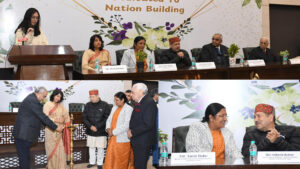
-
Event organised by Change.org and Youth Ki Awaaz at Bikaner House, looks at “ways to tackle the demand for children in the sex industry”
BCR NEWS (Ajay Shastri/New Delhi): The screening of a recently released film on child sex trafficking called Amoli threw up a debate on the rising demand for children in the commercial sex industry and the men who pay to have sex with minors.

The film features heart-wrenching stories of children who have been forced into the sex industry and interviews of survivors who have been rescued, families of girl children who are still missing and activists who have been attempting to create awareness on Commercial Sexual Exploitation of Children (CSEoC) and prevent the trafficking of children.
The screening was followed by a series of short Talks by eminent speakers and issue experts like Delhi Commission for Women Chairperson, Swati Maliwal; President Shakti Vahini, Ravi Kant; National award-winning actor Adil Hussain; India Today Associate Editor, Chinki Sinha and the filmmakers Avinash Roy and Jasmine Kaur.
The event was organised by Change.org and Youth Ki Awaaz at Bikaner House and was attended by an audience of young people who interacted with speakers during their talks.
Identifying severe gaps in existing frameworks that fail to penalise the customers who fuel the demand for children in the sex industry but punish survivors of trafficking instead, the speakers expressed an urgent need to create a holistic approach to tackle CSEoC.
Jasmine Kaur Roy, Director, Amoli, spoke on the power of cinema to impact the conversation around ‘customers’ who create the ‘demand for minors’. She said, “We hope Amoli will help in starting a conversation around the urgent need for reforms in reducing child trafficking cases. Our aim is to encourage policy makers to create laws that punish not just traffickers but also penalise the customers who foster the demand for minors.”
Avinash Roy, Writer & co-Director, Amoli, stressed on how cinema can be used as a tool to mainstream conversations around commercial sexual exploitation of children, said, “It is hard to estimate the exact number of trafficked minors in India. And we have tried to highlight that aspect through our film. We don’t expect a single film to resolve the issue of child trafficking, but hopefully, it sheds light on the institutional practice of trafficking in India.”
Swati Maliwal, Chairperson, Delhi Commission for Women, said, “As the head of the Delhi Commission for Women, I have led many raids and rescued minors from GB Road, which is a forced prison for thousands of children who have been trafficked and forcibly thrown into the flesh trade. I have also met children who were kidnapped and sold to these brothels. Most girls are given hormone injections so that they look older. And all of them are repeatedly raped. Sex trafficking is the worst form of slavery. Places like GB road have no place in a civilised society. They need to be shut down and the girls rehabilitated.”
Adil Hussain, a National Award-winning actor who has acted in films dealing with child trafficking, said, “I have been directly connected with child trafficking issues through my films, Sunrise in Marathi and the most recent globally released Love Sonia. My films are aimed at getting the audience to start conversations on neglected issues. We need to think why are children being targeted sexually. We need to understand the mindset of these criminals.”
Ravi Kant, President of Shakti Vahini, an organisation at the forefront of rescuing minors from child trafficking, said, “The level of investigation in human trafficking cases needs to be improved. The police must investigate the entire chain of traffickers to look into the source, transit and destination. Aspects of money laundering and organized crime must be investigated as supply of human trafficking victims through online medium is increasing. In order for this to happen the government needs to invest in building skills of law enforcement agencies and also provide them resources which is presently negligible.”
Chinki Sinha, Associate Editor, India Today, who has been writing about child trafficking in Delhi and Mumbai, said, “These are people on the periphery. They are not advertisers. They aren’t going to buy what is advertised. They are the invisibles. They are often reported in terms of numbers. Just that. How many of these children do we know by their stories? We are in the business of selling news mostly. We are no longer given the luxury to report on those who don’t constitute the target audience.”
Also showcased at the event was Kolkata-based artist and photographer Leena Kejriwal’s interactive art installation as part of her larger public art project called MISSING, aimed at sensitising the wider public on the plight of trafficked girls in India.
Speaking at the event, Leena Kejriwal, Founder, Missing Public Art Project said, ”The MISSING campaign’s main objective has been to engage the public on the issue of sex trafficking especially of young girls. We use art and technology for a larger public engagement. Trafficking is demand driven. The demand being created by the public leads to the supply of girls. To rock this boat, it is very important to create awareness on their role. The MISSING murals with the chatbot engages the public through graphic visuals and quotes and asks them to chat with the Mural to know more,” she added.
About Commercial Sexual Exploitation of Children
Commercial Sexual Exploitation of Children (CSEoC), one of the worst forms of human rights violations, is a demand-driven phenomenon, facilitated and perpetuated by those who exploit women and children, calling themselves as ‘customers’ and exacerbated by the nexus of traffickers and conspirators.
The main targets of this organized crime are minors and young girls, in particular. Trafficking of children for CSEoC is multi-deterministic in nature and is a result of several socio-cultural and socio-economic factors. It thrives on a demand and supply cycle which in turn is facilitated by societal agents and is aided by the easy availability of a large vulnerable population. CSEoC like any business model exploits children, among a nexus of ‘customers’ and the enablers, handlers, traffickers, conspirators, financers, pimps, etc. for profits.
About Change.org
Change.org is the world’s largest technology platform for social change. It allows people to start and support campaigns on issues that concern them. Change.org does not start petitions on its own. Over 1 crore people currently use Change.org in India.
About Youth Ki Awaaz
Youth Ki Awaaz is India’s largest citizen journalism platform. It represents young India’s voice on critical issues. By being a platform built for and by the people, it democratizes the media by putting citizens at the center of it. Youth Ki Awaaz provides a space for citizens to write and share stories on things that matter, and create an impact.







